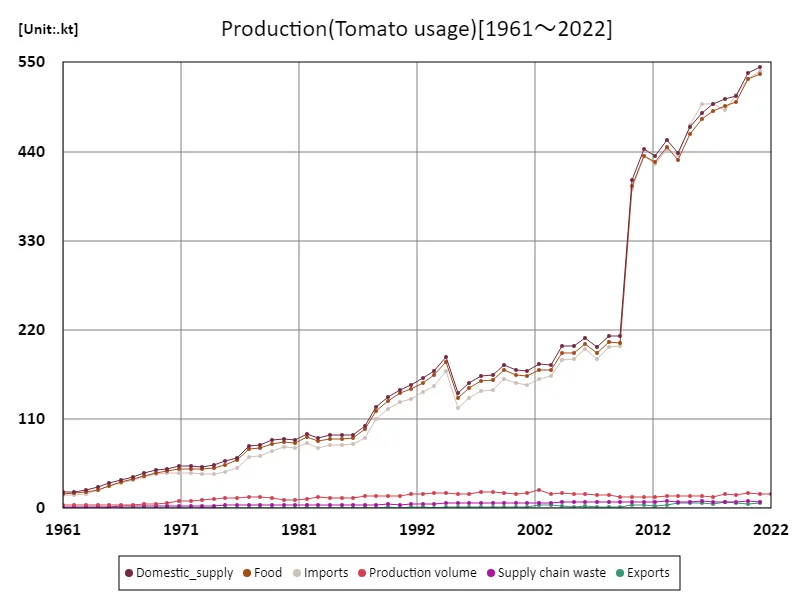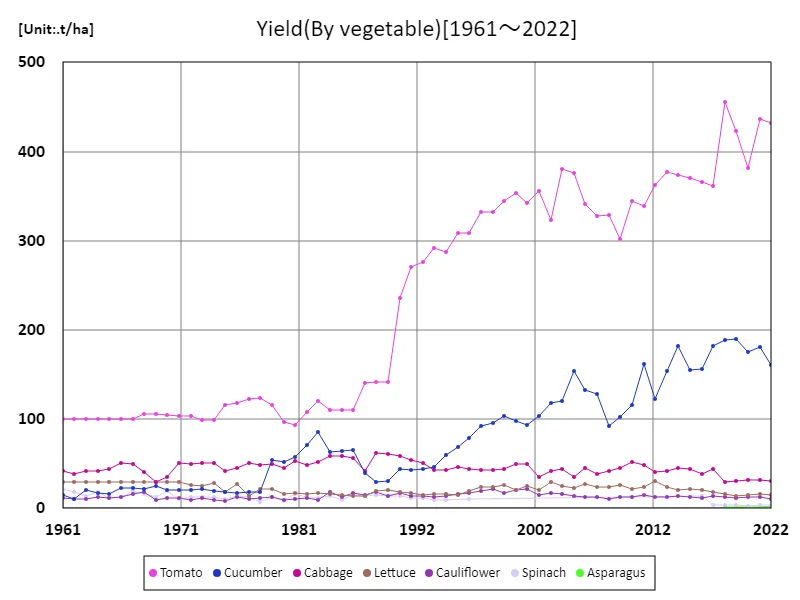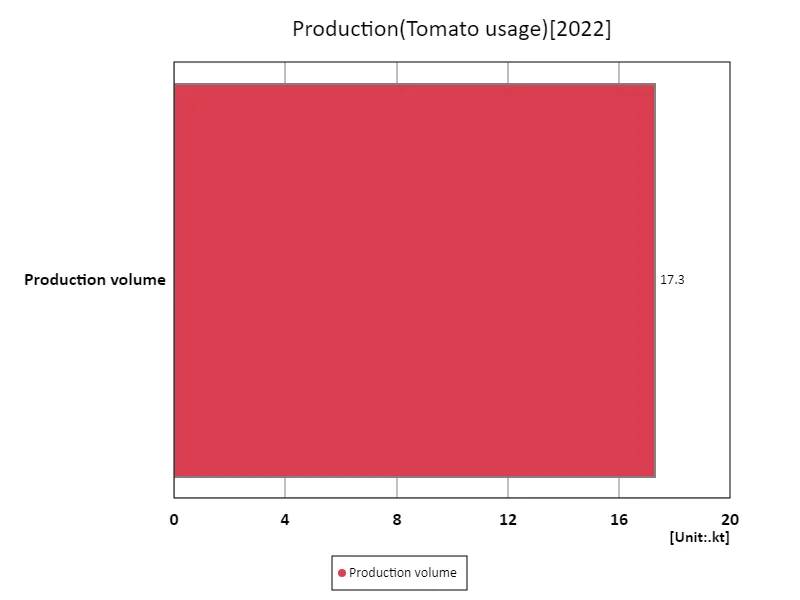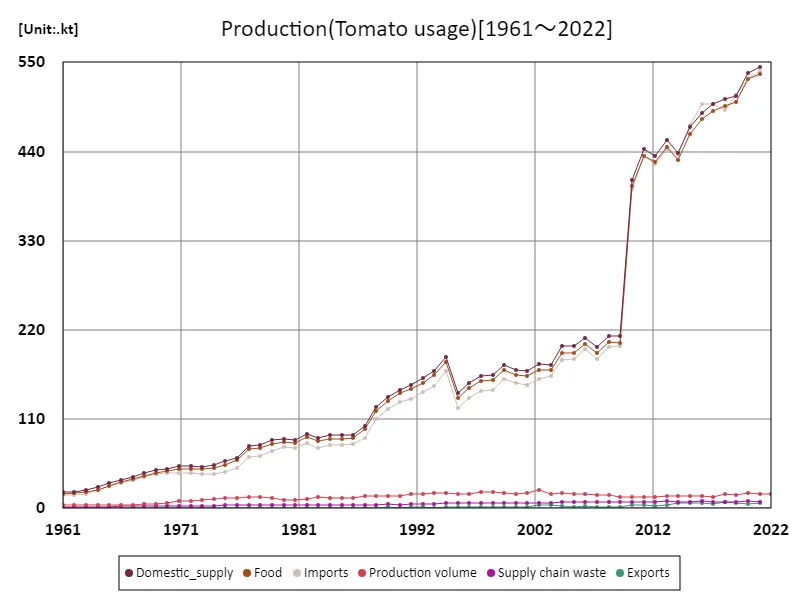Abstract
In Sweden, vegetable production has seen notable trends in recent years. In 2022, cucumbers led with a production volume of 36.9kt, reflecting consistent demand and growth. Historically, production has focused on a few key crops, with carrots, cabbage, and potatoes also making significant contributions. Cucumbers and tomatoes have increasingly dominated in land use and yield, particularly in controlled environments like greenhouses. Tomato production, often categorized by use, includes both fresh and processed forms, showing adaptability to changing consumer preferences. The sector has shifted towards more sustainable practices, optimizing yield per hectare.
Production (by vegetables)
Sweden’s vegetable production has evolved significantly since 1961, with cabbage historically holding the highest production at 48.5kt in 1985. Today, cabbage stands at 49.8% of its peak, reflecting a steady decline in production over the decades. This trend highlights shifts in consumer preferences, agricultural practices, and land use. While cabbage once dominated, other vegetables like cucumbers and carrots have gained prominence, particularly with advancements in greenhouse cultivation. Despite its reduced share, cabbage remains a staple in Swedish agriculture, with efforts focused on optimizing yield and sustainability.


The maximum is the latest one, 544kt of Domestic_supply
Yield(by vegetable)
Sweden’s vegetable production has experienced significant growth, with tomatoes reaching the highest yield of 456t/ha in 2018, currently at 94.8% of this peak. This reflects improvements in cultivation techniques, particularly in greenhouse environments, which optimize growing conditions and maximize yield. Over time, tomatoes have become a key crop, with consistent gains in yield per hectare. This trend mirrors Sweden’s broader agricultural shift towards high-efficiency, controlled-environment farming. Despite fluctuations, tomatoes continue to represent a major part of Sweden’s vegetable production, driven by technological advances and market demand.


The maximum is 456t/ha[2018] of Tomato, and the current value is about 94.8%
Land use (by vegetables)
In 2022, Sweden’s vegetable land use reached a peak of 17.3kt, reflecting a stable and consistent trend in the country’s agricultural practices. This level of land use has become the average and total for the year, indicating that Sweden’s vegetable production area has remained relatively unchanged in recent years. The consistency suggests a well-established balance in land allocation for vegetable farming, with key crops like cucumbers, carrots, and tomatoes utilizing the majority of the area. This trend emphasizes sustainable land management and efficient resource use, supporting a stable and diverse vegetable production system.


The maximum is 17.3kt of Production volume, the average is 17.3kt, and the total is 17.3kt
Tomato usage
Sweden’s tomato production has remained stable since 1961, with the highest recorded domestic supply at 544kt, which still stands as the peak. This consistent figure highlights the enduring importance of tomatoes in Sweden’s agricultural sector. Over the years, tomatoes have become a staple in domestic consumption, with increased production through greenhouse farming improving yield and quality. Despite shifts in other vegetable production, tomatoes have maintained a prominent position, driven by demand for fresh and processed products. This trend underscores Sweden’s commitment to domestic self-sufficiency in vegetable production.


The maximum is the latest one, 544kt of Domestic_supply
Main data
| Production(Tomato usage) [kt] | ||||||
|---|---|---|---|---|---|---|
| Domestic_supply | Imports | Food | Production volume | Supply chain waste | Exports | |
| 2022.0 | 17.29 | |||||
| 2021.0 | 544 | 539 | 535 | 17.46 | 8 | 6 |
| 2020.0 | 537 | 530 | 529 | 19.05 | 9 | 5 |
| 2019.0 | 509 | 510 | 501 | 16.9 | 8 | 6 |
| 2018.0 | 505 | 491 | 496 | 18.23 | 8 | 8 |
| 2017.0 | 498 | 498 | 490 | 14.45 | 8 | 5 |
| 2016.0 | 488 | 498 | 480 | 14.62 | 9 | 6 |
| 2015.0 | 470 | 473 | 461 | 14.79 | 8 | 6 |
| 2014.0 | 438 | 436 | 429 | 14.58 | 8 | 6 |
| 2013.0 | 454 | 443 | 445 | 15.1 | 9 | 4 |
| 2012.0 | 435 | 424 | 427 | 14.5 | 8 | 3 |
| 2011.0 | 443 | 434 | 435 | 13.54 | 8 | 4 |
| 2010.0 | 405 | 394 | 397 | 13.8 | 8 | 4 |
| 2009.0 | 212 | 200 | 204 | 13.6 | 8 | 2 |
| 2008.0 | 213 | 199 | 205 | 16.2 | 8 | 2 |
| 2007.0 | 199 | 184 | 191 | 16.4 | 8 | 2 |
| 2006.0 | 210 | 196 | 202 | 17.4 | 8 | 3 |
| 2005.0 | 200 | 184 | 192 | 17.27 | 8 | 2 |
| 2004.0 | 200 | 183 | 192 | 19.4 | 8 | 3 |
| 2003.0 | 177 | 163 | 171 | 18.09 | 7 | 4 |
| 2002.0 | 178 | 160 | 171 | 22.77 | 7 | 4 |
| 2001.0 | 169 | 152 | 163 | 18.8 | 7 | 2 |
| 2000.0 | 171 | 155 | 165 | 17.3 | 6 | 2 |
| 1999.0 | 177 | 159 | 170 | 19.3 | 7 | 2 |
| 1998.0 | 165 | 146 | 158 | 19.9 | 6 | 1 |
| 1997.0 | 163 | 145 | 157 | 19.9 | 6 | 2 |
| 1996.0 | 154 | 136 | 148 | 18.2 | 6 | 1 |
| 1995.0 | 142 | 124 | 136 | 18.2 | 6 | 1 |
| 1994.0 | 186 | 169 | 181 | 18.7 | 6 | 1 |
| 1993.0 | 169 | 151 | 164 | 18.66 | 5 | |
| 1992.0 | 161 | 143 | 155 | 18.19 | 5 | 1 |
| 1991.0 | 152 | 135 | 147 | 17.89 | 5 | 1 |
| 1990.0 | 146 | 131 | 142 | 15.54 | 4 | |
| 1989.0 | 137 | 122 | 132 | 15.54 | 5 | 1 |
| 1988.0 | 125 | 110 | 120 | 15.54 | 4 | |
| 1987.0 | 102 | 87 | 98 | 15.54 | 4 | |
| 1986.0 | 91 | 79 | 87 | 12.24 | 4 | |
| 1985.0 | 90 | 78 | 86 | 12.24 | 4 | |
| 1984.0 | 90 | 78 | 86 | 12.26 | 4 | |
| 1983.0 | 87 | 74 | 83 | 13.4 | 4 | |
| 1982.0 | 92 | 81 | 88 | 12 | 4 | |
| 1981.0 | 84 | 74 | 80 | 10.28 | 4 | |
| 1980.0 | 86 | 76 | 82 | 10.6 | 4 | |
| 1979.0 | 84 | 71 | 79 | 12.8 | 4 | |
| 1978.0 | 78 | 64 | 74 | 13.6 | 4 | |
| 1977.0 | 77 | 63 | 73 | 13.5 | 4 | |
| 1976.0 | 62 | 50 | 59 | 13 | 4 | |
| 1975.0 | 58 | 45 | 54 | 12.8 | 4 | |
| 1974.0 | 53 | 42 | 50 | 10.9 | 3 | |
| 1973.0 | 51 | 42 | 48 | 9.9 | 3 | |
| 1972.0 | 52 | 43 | 48 | 8.8 | 3 | |
| 1971.0 | 52 | 43 | 48 | 8.7 | 3 | |
| 1970.0 | 49 | 43 | 46 | 6.9 | 3 | |
| 1969.0 | 47 | 42 | 44 | 5.6 | 3 | |
| 1968.0 | 43 | 38 | 40 | 5.6 | 3 | |
| 1967.0 | 39 | 35 | 36 | 4.6 | 3 | |
| 1966.0 | 35 | 31 | 33 | 4.3 | 3 | |
| 1965.0 | 31 | 27 | 28 | 4 | 2 | |
| 1964.0 | 26 | 22 | 23 | 4 | 2 | |
| 1963.0 | 22 | 18 | 20 | 4 | 2 | |
| 1962.0 | 20 | 16 | 19 | 4 | 2 | |
| 1961.0 | 20 | 16 | 18 | 4 | 2 | |



Comments